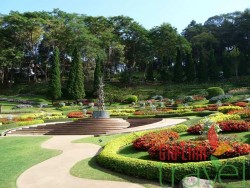Chiang Rai
Chiang Rai


Doi Tung

White Temple
Chiang Rai, the northernmost province of Thailand is about 785 kilometers north of Bangkok. Situated on the Kok River basin, Chiang Rai covers an area of approximately 11,678 square meters with an average elevation of 580 meters above sea level. The province, which is located within the renowned Golden Triangle area where Myanmar, Laos and Thailand converge, is also known as the gateway to Myanmar, Laos and Southern China.
Chiang Rai, which was founded in 1262 by King Meng Rai,
was the first capital of the Lanna Thai Kingdom (Kingdom of a million rice fields), which was later conquered by Burma. It was not until 1786 that Chiang Rai became a Thai territory and was proclaimed a province during the reign of King Rama VI in 1910.
Today, Chiang Rai is a traveler’s paradise endowed with abundant natural tourist attractions and antiquities; the province itself is evidence of past civilization. Attractions range from magnificent mountain scenery, ruins of ancient settlements, historic sites, Buddhist shrines and ethnic villages as the province is also home to several hill tribes who maintain fascinating lifestyles. For those interested in the natural side of Chiang Rai, jungle trekking is recommended along various trails.
Chiang Rai which tends to be a little more ‘laid back’ now competes with Chiang Mai as a tourist attraction and is fast becoming a popular escape for tourists wanting to get away from the troubles they left behind.
2. Highlights of Chiang Rai
Hall of Opium
Begin your exploration of the Golden Triangle area by visiting the Hall of Opium. This museum has already won one of the Pacific Asia Travel Association’s 2004 Gold Awards for Educational Programming. This fascinating experiential, interactive museum takes you on a highly informative journey through the history of opium and its paraphernalia. Beginning 5,000 years ago, when opium was used primarily for medicinal purposes, you walk through exhibits detailing its history to the tragic consequences of today’s recreational use.
Learning many new and interesting facts as you move throughout the museum (for example that the signer of the American Declaration of Independence, Benjamin Franklin, was addicted to opium to control pain), you end your journey in the thought-provoking Hall of Reflection. One of the quotations there could not express the museum’s message better: What is hateful to you, do not to your fellowmen. That is the entire law; all the rest is commentary Talmud Shabbat 31a.
Chiang Saen
If you’re an appreciator of ancient Lanna art, drive the short distance to Chiang Saen. Experiencing the low-key Chiang Saen of today, you would not guess that its history was much more turbulent and significant than this present-day sleepy little town would indicate.
Following Chiang Saen’s auspicious founding in 1328 by King Mangrai’s grandson, the city’s expansion was tragically interrupted by the Burmese invasions of Lanna in the 16th-18th centuries. As a defensive measure to recapture the city in 1814, King Rama I destroyed the town except for its temples. As late as 1876, a British surveyor noted a deserted city with temple remains and Buddha bronze images scattered about, remarking though that the bronzes were indeed quite splendid.
Wat Phra That Chedi Luang in the city centre is Chiang Saen’s main ancient wat. In spite of this site being a tour bus stop, you can still bathe in the majesty of the past by ignoring the make-shift viharn with its surrounding tourist vendor stalls. Instead, walk straight to the impressive Lanna style chedi behind the viharn. This magnificent 58-metre tall octagonal chedi, built in the 14th c. stands supremely alone covered in lichen and wrapped in its sacred saffron sash.
To get a glimpse of the splendid Buddha bronzes that the British surveyor saw scattered on the ground in 1876, step next door to the National Museum. This small but exquisite collection houses some magnificent pieces.
Experience the vanished majesty of Chiang Saen in tourist-free splendor by visiting Wat Pa Sak just outside the old city gate. This ancient monastery complex, whose name means Temple of the Teak Forest, still stands in ruins among scores of teak trees out of the original 300 planted here.
Doi Tung
Don’t miss a visit to Doi Tung. This mountainous area is permeated with the presence and philanthropic work of HRH the Princess Mother who died in 1994. There are three interesting places to visit here: The Princess Mother Commemorative Hall outlining the life and work of nearly a century of this much-beloved lady. Secondly, the beautifully landscaped Mae Fah Luang gardens are a delightful walk before you ascend the winding driveway to the Doi Tung Royal Villa.
The Doi Tung Royal Villa was the residence of the Princess Mother when she visited Chiang Rai. The view from the northern terrace overlooking the Burmese and Thai mountains is stunning. Inside the Grand Reception Hall resides a gigantic embroidery work filling an entire wall – a gift from the villagers in Chiang Mai, aware of the Mother’s love of embroidery, the piece is delicately crafted.
On your way down the mountain, don’t forget to look in on some of the workshops comprising the Doi Tung Development Projects initiated in 1988 by the Princess Mother as self-help endeavors for the peoples of the highlands.
